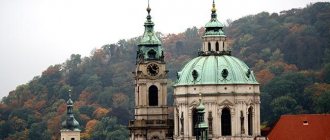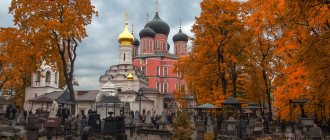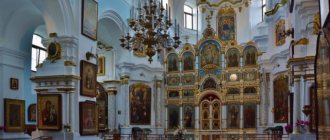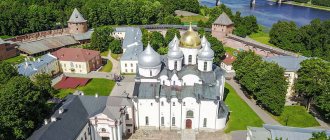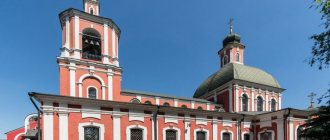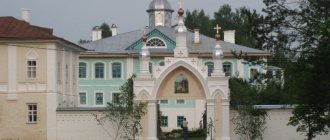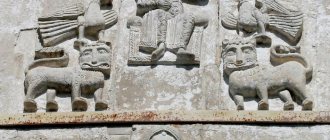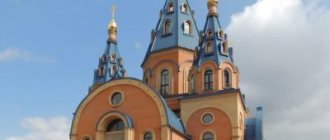At the dawn of religions, religious buildings began to be erected on the site of ancient temples to offer praise to God and conduct religious ceremonies.
But the meaning of temples has become much broader over time, because their design and architectural elements convey an understanding of the universe. It is not for nothing that in the Proto-Slavic languages there was the word “chormъ” - house, and the ancient Egyptians and Greeks believed that temples were the dwellings of the gods.
Almost all religions have a tradition of erecting religious buildings. So let’s look at the buildings of all religions, and find out what is the largest temple in the world, of those that were erected both in ancient times and in modern times.
The largest temples on the planet:
12
Cologne Cathedral. Germany
The Catholic Cathedral in Cologne, Germany is a striking example of classical medieval Gothic, and construction began on it back in 1248. It acquired its final form in the 80s of the 19th century.
The height of the towers of this magnificent monument of European architecture reaches 157 meters, making it the tallest temple in the world.
11
Spas on Spilled Blood, 81 m. St. Petersburg
The Church of the Savior on Spilled Blood is so named because... was built in the very place where in 1881 there was an attempt to assassinate Alexander II. He was seriously wounded and died soon after. That is, once upon a time something like a monument to a martyred ruler was built. It is located in the center.
Alexander III, the son of the deceased emperor, ordered construction to begin. It began in 1883 and ended in 1907, at which time it was consecrated.
In 1930, the temple was closed, they planned to dismantle it, but then they had to forget about it. In besieged Leningrad, the cathedral turned into a morgue. In 1970, it became a branch of the St. Isaac's Cathedral Museum, and its restoration began in the 80s.
Cathedral of Christ the Savior. Russia
Restored in the 90s of the twentieth century in Moscow, the Church of the Savior is today the tallest Orthodox church, with a height of 106 meters.
It was erected according to the design of the architect Konstantin Ton in honor of the Russian soldiers who fell in the war with Napoleon. It was a kind of collective cenotaph (a burial without the deceased), on the walls of which the names of officers who died between 1797 and 1814 were inscribed.
10
Alexander Nevsky Lavra
The Alexander Nevsky Lavra includes burials represented by the graves of many great brilliant representatives of Russian culture, including Tchaikovsky, Dostoevsky and Glinka.
The monastery was founded in July 1710 - seven years after the founding of St. Petersburg by Peter the Great. This was during the Northern War between Russia and Sweden, so its location had symbolic significance.
In 1724, the new church, designed by the Italian architect Domenico Trezzini, was consecrated. It was named after Alexander Nevsky, who is considered a saint in Russian Orthodoxy, and whose remains were brought there from the ancient city of Vladimir.
The temple, using an incredible amount (one and a half tons) of pure silver, was decorated with symbols reflecting the famous battle on the ice on Lake Peipsi in 1242 and other places of Alexander’s victories.
Church of Saint Sava. Serbia
Modeled after the Hagia Sophia of Constantinople, the Cathedral of Saint Sava in Belgrade is the largest Orthodox church in terms of area.
This beautiful building of Orthodox architecture was built in the classical Byzantine style, and the history of its construction is full of drama. The work that began in 1935 was interrupted by the war, then the ban on religion during the Soviet period, and construction was only completed now.
9
Church-bell tower in the name of the Resurrection of Christ at Rogozhskoye Cemetery, 80 m. Moscow
The center of the Moscow Old Believers, the historical district of this city is Rogozhskaya Sloboda. There you can see the bell tower, built in 1906-1912. It was built according to the design of Fyodor Gornostaev. According to some reports, its height is not 80 m, but 64 m.
Construction of the bell tower was completed in 1911, but work was still underway on its painting. Finishing and decoration. The consecration took place in 1913. The facade of the bell tower church in the name of the Resurrection of Christ was decorated with images of birds of paradise. The total weight of all bells was 3 thousand pounds. A book depository was made on the second tier.
In 1933, the church-bell tower in the name of the Resurrection of Christ was closed, the bells were sent for melting, and the books and manuscripts were transferred to the library. The building itself was turned into a warehouse.
During the war they wanted to blow up the bell tower, but it survived. After the war, the temple was restored, and the huge bell was returned in 1990. Now this temple is operational, it has an icon depository and an archive of ancient books.
Notre-Dame de la Paix. Ivory Coast
The Basilica of the Blessed Virgin Mary, erected in the capital of the state, the city of Yamoussoukro in 1989, was included in the Guinness Book of Records due to the fact that it occupies a huge area of 30 thousand square meters.
The dome of the temple soared into the sky to a height of 158 meters. Despite its impressive size, no more than 18 thousand believers can fit inside the building during services.
8
Basilica del Pilar, Zaragoza, Spain, 8,318 m²
The construction of the current Basilica of Nuestra Señora del Pilar de Zaragoza has its justification in the increase in the number of Christians in Spain during the seventeenth century.
The previous Gothic-Mudéjar building remained small in the face of the growing number of believers. It was then that the need arose to build a new church of a larger size, more consistent with the Church of the Counter-Reformation.
It was in 1660 that Juan Joseph of Austria, then Viceroy of Aragon, promoted the construction of the basilica. The current exterior of El Pilar is the result of a long design process that began with a design by the architect Felipe Sánchez in 1681 and was subsequently revised by Francisco de Herrera “El Mozo”, artist and architect to Charles II.
The intervention of the Royal Architect Ventura Rodriguez from 1750 was decisive. He updated the interior decoration in accordance with the new classicist trends of the time. He also reconstructed the outer route with domes added to the central one, which was originally thought to be the only one, and towers that would not be completed until the mid-twentieth century.
The basilica preserves and venerates a pillar, a column made of jasper, which, according to legend, was erected by the Virgin Mary herself, who, while still living in Jerusalem, appeared to the Apostle James on January 2, 40. The Basilica of Pilar brings together works of great artistic value from different eras, including frescoes painted by Goya, restored in 2007.
Sky Temple. China
The monumental temple and monastery complex covers an area of 267 hectares and is located in the heart of Beijing, and is the largest sanctuary of Buddhism.
The round temple, erected in 1420, was originally called the Temple of Heaven and Earth, but after the construction of a separate religious building on earth, it received its current name.
7
LiveInternetLiveInternet
Alya the Needlewoman
all posts by the author The concept of “biggest” is very relative.
In Islam, the largest mosques are counted by the number of minarets.
In Christianity (both Catholic and Orthodox), the largest churches are counted by height.
In Buddhism and Judaism everything is very unclear; neither height nor spaciousness plays a role.
But the main purpose of religious buildings is to convey the words of the Almighty to believers.
How many believers can the temple accommodate? This is probably the main thing.
The largest mosques
Mosque al-Haram (Forbidden, Sacred Mosque) in Mecca, Saudi Arabia
This is the main and largest mosque in the world, in the courtyard of which is the main shrine of Islam, the Kaaba.
source
The mosque was built in 638.
The capacity of the mosque is 900 thousand people (during the Hajj up to 4 million people)
The area of the mosque is 357 thousand square meters. meters.
The mosque has 9 minarets of 89 meters each.
The Kaaba is a Muslim shrine in the form of a cubic structure in the courtyard of the Holy Mosque
The Kaaba serves as a landmark to which Muslims around the world turn their faces during prayer.
From 2007 to 2012, by decision of the King of Saudi Arabia, Abdullah bin Abdulaziz Al-Saud, a new large-scale reconstruction of the mosque was carried out. During the expansion, mainly in the northern direction, the territory increases to 400 thousand square meters. meters and will accommodate 1.12 million people. Two more minarets are under construction.
Masjid al-Nabawi (Prophet's Mosque) in Medina, Saudi Arabia
Is the second holiest shrine of Islam
Here is the tomb of the Prophet Muhammad
The mosque was built in 622.
The capacity of the mosque is 600 thousand people (during the Hajj up to 1 million people)
The area of the mosque is 400.5 thousand square meters. meters (so far more than the Sacred Mosque)
The mosque has 10 minarets of 105 meters each.
Under the Green Dome, the Holy Tomb of the Prophet Muhammad is located
The largest Catholic cathedrals
St. Peter's Basilica in Vatican
The main center of the Roman Catholic Church, the burial place of most popes.
The first basilica was built in 326, its current appearance dates back to 1626
The area of the cathedral is 22 thousand square meters
The cathedral's capacity is about 60 thousand people.
St Paul's Cathedral in London, UK
It is the residence of the Bishop of London and the tomb of almost two hundred of the most famous citizens of Great Britain.
The cathedral was rebuilt 5 times. The first (wooden) cathedral was built in 604, the fifth (stone) was built in 1708.
The cathedral's capacity is 40 thousand people.
There are 17 bells installed in the bell towers of the Cathedral
The largest Orthodox cathedrals
St. Michael's Cathedral in Cherkassy, Ukraine
Built in 1994-2002 and named after the Archangel Michael.
The height of the bell tower is 134 meters
The cathedral's capacity is 12 thousand people.
Cathedral of Christ the Savior in Moscow, Russia
The temple has the status of the Patriarchal Metochion.
The first temple was built in 1839 -1883 in memory of the victory in the Patriotic War of 1812
On December 5, 1931, it was destroyed by two explosions (after the first explosion, the temple survived)
In 1937, construction of the Palace of Congresses began, but it did not rise above the foundation.
From 1960 to 1994, there was an outdoor swimming pool "Moscow" on this site.
In 1994 - 1997 the temple was rebuilt
The cathedral's capacity is 10 thousand people.
Church of Saint Sava in Belgrade, Serbia
The temple was built on the site where the first Serbian archbishop and national hero of Serbia, Saint Sava, was burned by Ottoman authorities in 1594.
Construction of the temple began in 1935
The area of the cathedral is 7570 square meters
The capacity of the temple is 10 thousand people
The largest synagogues
Temple Emanu-El New York, USA
Translated from Hebrew, “Emanu-El” means “The Lord is with us.”
Temple Emanu-El, built in 1845, is open to people of all faiths.
Has 5 prayer halls
The capacity of the temple is 2500 people (main hall), 5550 people (in all halls)
Synagogue in Budapest, Hungary
The Great Synagogue of Budapest is the largest synagogue in Europe.
The synagogue was built in 1854-1859.
The capacity of the synagogue is 3,000 people (based on the number of seats)
The largest Buddhist temples
Borobudur complex on the island of Java, Indonesia
Borobudur was built between 750 and 850 years.
Borobudur was built as a huge stupa in the shape of a mandala. The foundation of the stupa is square, with a side of 118 m. The stupa has eight tiers: the lower five are square, and the upper three are round. On the upper tier there are 72 small stupas around a large central one. Each stupa is shaped like a bell. Inside the stupas there are 504 Buddha statues and 1,460 bas-reliefs of religious subjects.
Borobudur is still a place of pilgrimage and prayer. Pilgrims walk seven times clockwise on each level. Touching each Buddha from the stupas on the upper tier is believed to bring happiness.
Golden Abode of Buddha Shakyamuni in Elista, Kalmykia, Russia
Elista is considered the center of Buddhism in Europe, and the temple is the largest in Europe.
The temple contains a 10-meter statue of Buddha (the largest in Russia and Europe)
The temple was completed in 2004.
The largest Hindu temples
Swaminarayan Akshardham (translated as "Abode of God") in Delhi, India
The temple opened in 2005, in fact it is a “remake”
The height of the temple is 42 meters, length -106 m, width -94 m. The area of the entire complex is 12 hectares
Every evening on the territory of Akshardham there is a laser show with dancing fountains built in the shape of a lotus and located inside a huge bowl.
The complex has several parks, a museum, a large cultural center where you can get acquainted with the national characteristics and traditions of India, water canals along which you can sail by boat, as well as many cafes and souvenir shops.
Alya the Needlewoman
Saint Isaac's Cathedral. Russia
The churches of Russia are majestic and cannot but arouse admiration. The cathedral, erected in the first half of the 19th century in St. Petersburg on the site of a wooden church that previously stood here, is a classic example of Latin architecture.
Today it is the State Museum, but since 1991 the Orthodox community of the city received the right to hold services in the cathedral. The height of the building itself is 101 meters 50 centimeters.
6
Bell tower of the Kazan Mother of God Monastery - 99.6 m
The Kazan Mother of God Monastery is a male monastery located in Kazan, in the city of Tambov. The Tambov Theological Seminary is located in the temple buildings. The monastery operates a Sunday school for children and adults. The multi-tiered monastery bell tower, the construction of which was completed in 1848, was demolished during the Soviet years. On the site of the bell tower, school building No. 32 was built, and on August 10, 2007, the ceremonial lighting of the cross and foundation stone took place. However, already in the spring of 2009, construction began on a new gate bell tower, the height of which is now 99.6 meters.
So we looked at the 5 tallest Orthodox bell towers in Russia, each of which captivates the eyes of anyone who has ever stood next to these architectural masterpieces.
Lotus Temple. India
One of the main places of worship of the Bahai religions was built in 1986 in New Delhi. The temple stands out not only for its original shape, but also for its enormous size.
Entrance to it is open to people of any religion, so thousands of pilgrims come to see this architectural miracle.
And on our website topcafe.su there is a very interesting article for you about the most unusual religions of the world.
5
Tallest temple in the world
Cathedral of Christ the Savior in Moscow. Its height is 103 meters - it is almost a 40-story building. But the architect of the temple, Konstantin Ton, created such proportions that from the outside the cathedral does not seem so tall or large. Big? Yes. The largest, or especially the tallest, no.
You begin to realize the scale when you find yourself inside. The central altar is the size of a parish church. The vaults are breathtaking.
photo: patriarchia.ru
At the same time, unlike Catholic cathedrals, the size of which is also amazing, in the Cathedral of Christ the Savior there is no feeling that you are a small person (they say this is a feature of the Latin style - to give a person the feeling that he is an ant compared to God). You are part of the whole building, this is your home. A feeling that is so close to an Orthodox church...
This cathedral had an unusual and difficult history - to begin with, it was originally supposed to be completely different (completely), and stand not on Volkhonka, but on Vorobyovy Gory. But that's a completely different story.
Hassan II Mosque. Morocco
The Islamic shrine, built in the 80-90s of the last century in Casablanca, has the highest minaret at 210 meters.
25 thousand believers can pray inside the mosque, and about 80 thousand more can pray in the square near the main building. The most beautiful and majestic monument of Islam was painted by 10,000 artists.
4
Kul Sharif Mosque
The Kazan Kul Sharif mosque is one of the largest churches in Russia. This is the main shrine of Tatarstan, the construction of which was completed in 2005. It is located on the territory of the Kazan Kremlin, being today one of the main attractions of the city.
Construction of the mosque began in 1996. The architects planned to recreate the legendary multi-minaret mosque, which in ancient times was located in the capital of the Kazan Khanate. It was the center of the development of science and religious education throughout the Middle Volga region in the 16th century. The mosque was destroyed in 1552 as a result of the storming of the city by the troops of Ivan the Terrible. The restored religious building is named in honor of Kul Sharif, the last imam who led the defense of Kazan.
The mosque itself is designed for one and a half thousand people, and the square in front of it can accommodate another ten thousand believers. The mosque has become the hallmark of the city; it is clearly visible from the Kazanka River and Millennium Square.
The mosque has one dome and six minarets, the height of which is 58 meters. They are made of marble and granite.
Tsminda Sameba. Georgia
Translated from Georgian, the name translates to “Holy Trinity”, and it is the main cathedral of the Georgian Orthodox Church.
Together with the cross, its height is 96 meters, but due to the constant subsidence of the building, its height is decreasing. Tsminda Sameba was consecrated nine years after its foundation, in 2002 on the Day of St. Gregory the Victorious.
Trinity-Izmailovsky Cathedral, 80 m. St. Petersburg
This cathedral is located where a wooden chapel once stood. In 1733, a camp temple-tent was erected here for the summer period for the Izmailovsky regiment. When the regiment moved, the temple was moved to the barracks.
In 1754 they began to build a wooden church, services in which were held only in the summer, because... he was cold. But in 1824 there was a severe flood, from which the church almost collapsed. In 1828, they began to build a new temple, for which Nicholas I himself allocated money, this time made of stone.
The illumination of the Trinity-Izmailovsky Cathedral took place in 1835. Once upon a time, there was a charitable society attached to the church that looked after an orphanage and almshouse. The cathedral was closed in 1938. In 1990 the church was returned.
Buddhist temple Borobudur. Indonesia
The most unique and architecturally unusual religious building began to be built in the early Middle Ages in 800. But it was abandoned for a long period of time, and restored only in the twentieth century.
The Buddhist shrine, consisting of multiple architectural elements and sculptural objects, has become a major site for pilgrimage and tourism.
2
Trinity Cathedral, 78 m. Pskov
The main building of Pskov Krom is the Holy Trinity Cathedral . The modern building, the 4th in a row, was built in 1699, and the 1st cathedral appeared by order of Princess Olga in the tenth century. It burned down in the twelfth century, and a stone one was built in 1138. In 1363 the temple collapsed, and 2 years later they began to build a new one on the preserved foundation.
In 1609 there was a strong fire when everything burned down. In 1682, construction of a new building began. It extends up to 78 m.
Masjid-ul-Haram Mosque. Saudi Arabia
In the main shrine for all Muslims, 700 thousand people can pray at once. Every Muslim should make a pilgrimage to Mecca at least once in his life, which is why the mosque was built so large.
The main shrine of Islam, the Kaaba, is located in the center of the courtyard, and the mosque itself is intended for collective prayers.
1
Cathedral Mosque
Islam is the second most popular religion in Russia, so there are plenty of large mosques in the country. For example, this is the cathedral mosque in Surgut, which can accommodate about two thousand people.
It is the largest in the entire Urals and Siberia. Not long ago a madrasah opened.
The prayer hall of the mosque was painted by masters from Ufa and Naberezhnye Chelny. The parishioners themselves collected money for its construction.
Saint Paul's Cathedral. Vatican
The largest and most majestic temple of the Catholic religion was founded in 1626, although the first basilicas on this site were erected during the reign of Emperor Constantine.
In the photo: St. Peter's Basilica - the largest church in the world
For a long time the building served as a church, and with the rise of the popes it became their main residence. Up to 60 thousand believers can be inside the cathedral at the same time, and more than 400 thousand can freely fit in the square in front of the cathedral.
⛪️
Golden Abode of Buddha Shakyamuni
The largest Buddhist temple in Russia is the Golden Abode of Buddha Shakyamuni, which is located in Kalmykia. Its construction in Elista was completed in 2004.
The 63-meter building of the khurul houses the largest Buddha statue in Russia. Its height is as much as nine meters. The khurul itself is made on seven levels.
On the lower floor there is a museum, a library and a conference room, on the second there is a prayer room, in which the same 9-meter statue of Buddha is located. Inside it are many sacred relics - incense, mantras, jewelry, plants and grains growing on the territory of Kalmykia, handfuls of earth brought from all regions of the republic. It is noteworthy that the statue itself is encrusted with diamonds and covered with gold leaf.
On the third level of the khural there are rooms for individual receptions, in which Buddhist monks receive believers. On the fourth level is the residence of the head of the Buddhists of Kalmykia, and on the fifth is the residence of the Dalai Lama, on the penultimate level are utility rooms, and on the seventh is a meditation room intended only for the highest clergy.
City view
From the observation deck of the bell tower of the Peter and Paul Cathedral there is a beautiful view of the entire city. A visit to the Peter and Paul Fortress itself is free, but in order to go up to the observation deck, you will have to purchase a ticket. The cost for an adult will be 450 rubles, for a schoolchild - 250. And once inside, it is possible to buy a pass to the very top. Each adult will have to pay an additional 150 rubles, and schoolchildren - 90.
Please note that if your plans also include visiting museums on the territory of the fortress, then it would be reasonable to purchase a comprehensive ticket for 600 rubles. It is valid for two calendar days and allows you to visit the Peter and Paul Cathedral, the Trubetskoy Bastion prison, the Grand Ducal Tomb, and the exhibition “History of St. Petersburg-Petrograd. 1703-1918", Museum of Cosmonautics and Rocket Technology. However, to visit the observation deck of the bell tower of the Peter and Paul Cathedral you will still have to buy an additional ticket.
Tours go up to the bell tower four times a day. Groups meet at 11:30, 13:00, 14:30 and 16:00. For accompaniment, the guide will have to pay an additional 150 rubles for an adult visitor and 90 for a schoolchild.
If you wish, you can climb the stairs to the bell tower yourself. This option has an undeniable advantage: in this case, you won’t have to jostle on narrow stairs.
If the height of the building itself is 122 and a half meters, then the observation deck is located at a level of 43 meters. In the very base of the bell tower, do not miss three burials that belong to Marya Alekseevna (the sister of Emperor Peter I), as well as the ruler’s son Alexei Petrovich and his wife Princess Charlotte-Christina-Sophia.
The visitor will find himself at the lower level of the bell tower, having overcome worn-out steps. Here it is worth paying attention to the material from which they are made. It's natural stone, so it's slippery after several million tourists have walked up the stairs.
Level with the roof of the cathedral at a height of 16 meters there is a museum of the construction of the bell tower itself. It details three centuries of its existence. For example, in one of the display cases you can see an exhibit of a model of the cathedral from 1733, as seen by the architect Domenico Trezzini. During the Great Patriotic War, when Leningrad was under siege, it was here that the air defense point was located.
The next level is at a height of 24 meters. Here you can finally hear the ringing of bells, and the carillon that accompanies it is installed on wooden beams. It is interesting that the very first carillon appeared here during the life of Peter I, but it has not survived to this day. It was restored relatively recently, in 2003, when the 300th anniversary of the founding of St. Petersburg was celebrated. The Royal Belgian School of Carillon provided significant assistance in this regard.
The current carillon is considered one of the largest on the entire European continent. It includes 51 bells, the total weight of which is about 15 tons. And the total weight of the entire tool is 25 tons. The largest of the bells that make up the modern carillon was cast with the personal savings of the Belgian Queen Fabiola. It bears a royal crown weighing three tons.
The smallest of the bells weighs only ten kilograms, and its diameter does not exceed 19 centimeters. It is noteworthy that the bells themselves are motionless. In order for the carillon to operate, a special person controls it from a remote control to which the tongues of all the bells are attached.
Directly above the carillon there is a lower belfry, more traditional for a classical Orthodox church. The bells ring there just like in ancient times. To do this, ropes are tied to the tongues of the bells. The largest bell here weighs five tons, is more than a meter in diameter, and was cast under Emperor Nicholas II in Gatchina.
At a level of 42 meters, the observation deck is limited in area. From here you have a beautiful view of St. Petersburg. While leisurely strolling around the observation deck, you can admire real postcard panoramas of the Northern capital. Of course, for this it is better to choose a time when the weather is good, but, as everyone knows, the climate of St. Petersburg is so unpredictable and changeable that it is not always possible to guess.
Bell tower of the Nikolo-Berlyukovskaya Hermitage - 90.32 m
The village of Avdotino is located 42 km from Moscow. There, on the Vora River, the Nikolo-Berlyukovsky Monastery . Initially, a wooden bell tower with a porch was built here. It was two stories high. In 1827, new bell towers were erected, not very high.
But in 1895, Fyodor Samoilov, a Moscow merchant, donated 30 thousand rubles, a huge amount of money at that time. They built a new one in 4 years. It was designed by Moscow architect A.S. Kaminsky, his student V.M. supervised the work. Borin.
In the 1st tier there was an entrance gate, in the 2nd there was a large festive bell, in the 3rd tier there was a bell ringing, which had 15 bells, and in the 4th tier there was an o’clock ringing. At the very top there was an eight-pointed cross made of copper, but gilded, this was the work of I.F. Shuvalova. Construction began in 1895 and was completed in 1899.
Nikolo-Ugreshsky Monastery - 93 m
The Nikolo-Ugreshsky Monastery is a male monastery located in the Moscow region, more precisely in the city of Dzerzhinsky. It was founded back in 1380.
In 1758-1763, a separate bell tower was built according to the designs of the architect Ivan Zherebtsov. In Soviet times it was truncated, but then restored again. In 1850, it was completed to 6 tiers, the height of which was 93 m. 18 bells were placed in it, the heaviest of which was called “Blagovestnik”, it weighed 19.7 tons. In Soviet times, it was destroyed.
